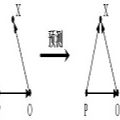Networks provide a powerful formalism for modeling complex systems, by representing the underlying set of pairwise interactions. But much of the structure within these systems involves interactions that take place among more than two nodes at once; for example, communication within a group rather than person-to-person, collaboration among a team rather than a pair of co-authors, or biological interaction between a set of molecules rather than just two. We refer to these type of simultaneous interactions on sets of more than two nodes as higher-order interactions; they are ubiquitous, but the empirical study of them has lacked a general framework for evaluating higher-order models. Here we introduce such a framework, based on link prediction, a fundamental problem in network analysis. The traditional link prediction problem seeks to predict the appearance of new links in a network, and here we adapt it to predict which (larger) sets of elements will have future interactions. We study the temporal evolution of 19 datasets from a variety of domains, and use our higher-order formulation of link prediction to assess the types of structural features that are most predictive of new multi-way interactions. Among our results, we find that different domains vary considerably in their distribution of higher-order structural parameters, and that the higher-order link prediction problem exhibits some fundamental differences from traditional pairwise link prediction, with a greater role for local rather than long-range information in predicting the appearance of new interactions.
翻译:网络为建模复杂的系统提供了强大的形式主义,它代表了基本的双向互动。但是,这些系统中的许多结构都涉及一个不止两个节点之间的同时互动;例如,一个小组内部的沟通,而不是人对人之间的沟通,团队而不是一对共同作者之间的协作,或者一组分子而不是两组共同作者之间的生物互动,或者一组分子而不是两组分子之间的生物互动。我们提到在两个以上节点的一组上两个节点上的这种同时互动是更高级互动;它们是无处不在的,但对这些系统的实验性研究缺乏评价更高级模型的总体框架。在这里,我们引入了一个基于链接预测的框架,这是网络分析中的一个根本问题。传统联系预测问题试图预测网络中新联系的出现,而我们在这里,我们将其调整为预测哪些(更大的)元素组将在未来产生互动。我们研究19个数据集在时间上的演进,我们用更高级的组合预测来评估结构特征的类型,而这些结构特征最能预测新的多线互动。我们发现,在网络分析中,传统联系是更高级的,我们发现,在结构上与更高级的排序上,在结构上,我们发现,在结构上,在结构上,在结构上,在结构上,在更深刻的对比上,在结构上,在结构上,我们发现,在结构上,在结构上,在结构上,在结构上,在结构上,在结构上,在结构上,在结构上,在结构上,在结构上,在结构上,在结构上,在结构上,我们发现,在结构上,在结构上,在结构上,在结构上,在结构上,在结构上,在结构上,在结构上,在结构上,在结构上,在结构上,在结构上,我们发现,在结构上,在结构上,在结构上,在结构上,在结构上,在结构上,在结构上,在结构上,在结构上,在结构上,在结构上,在结构上,在结构上,在结构上,在结构上,在结构上,在结构上,在结构上,在结构上,在结构上,不同上,在结构上,在结构上,在结构上,在结构上,在结构上,在结构上,在结构上,在结构上,我们联系联系联系联系联系联系联系联系




